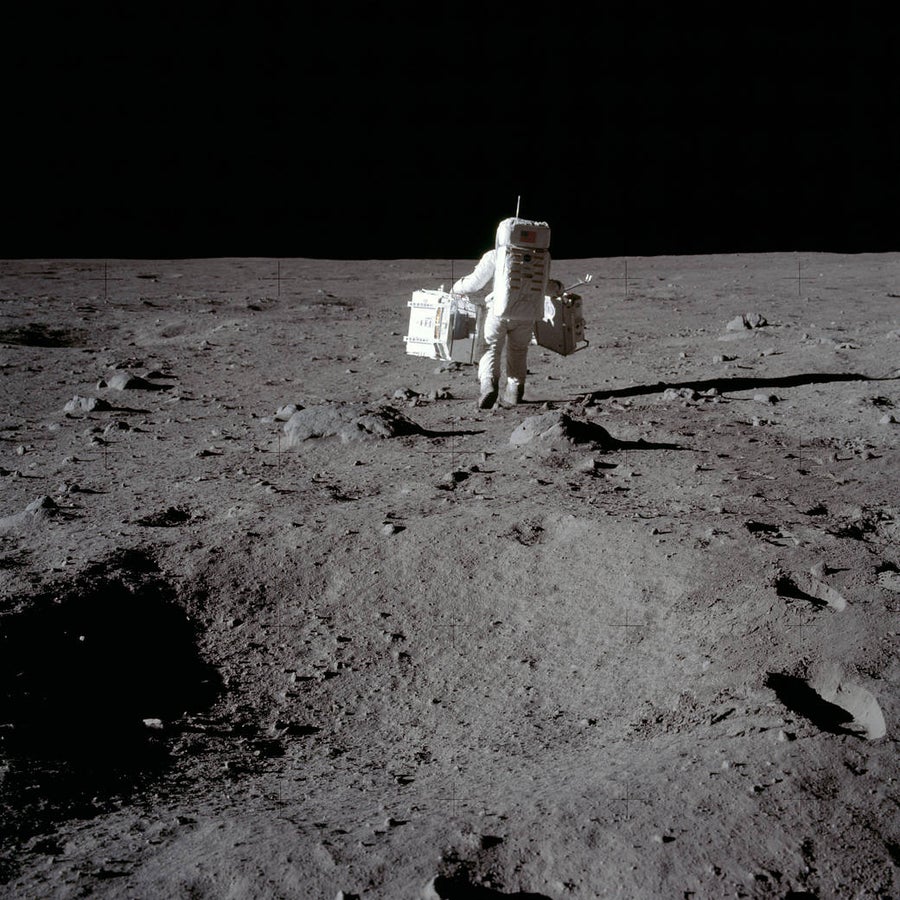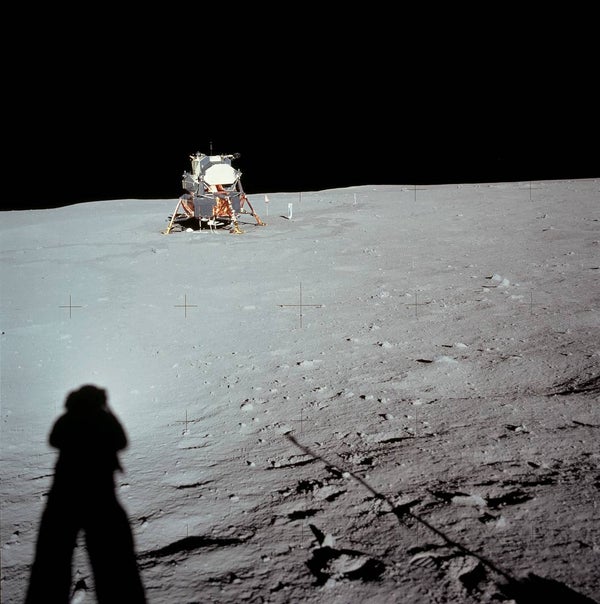This article was published in Scientific American’s former blog network and reflects the views of the author, not necessarily those of Scientific American
On this calendar day (July 20th) in 1969 NASA’s Apollo 11 lunar module, the Eagle, landed successfully on the surface of our moon. The rest, as they say, is history.
Except a lot of that history gets simplified and bundled out of sight. It can be easy to forget that for the Apollo 11 crew of Armstrong, Aldrin, and Collins this mission was a full 8 days long. That’s a lot of time to be thinking and doing, and talking about what you’re thinking and doing. And pretty much everything the astronauts were talking about got recorded, much by onboard magnetic tape recorders, later downloaded to Earth.
The full transcripts of NASA’s human lunar missions are available with the click of a mouse or tap of a screen these days. For fun, and in honor of this anniversary of the first time humans landed on another world, I thought I’d post some interesting snippets from the Apollo 11 recordings (you can read them all for yourself here or here). These transcripts represent a vivid window into the experience of the astronauts, and a good reminder of just how incredibly human they were in the midst of being completely on task.
On supporting science journalism
If you're enjoying this article, consider supporting our award-winning journalism by subscribing. By purchasing a subscription you are helping to ensure the future of impactful stories about the discoveries and ideas shaping our world today.
Take for example this bit of dialog between the whole crew in orbit around the Moon prior to landing (I’ve taken out the timestamps and identifiers, but you can piece together who’s saying what – especially when it comes to ‘moose’ and ‘big mothers’ - really):
Day 4, observing the lunar surface from orbit and taking images:
Yes, I see him.
He's coming your way.
That dark spot.
Oh, let me - here, let me - -
Well, there's no doubt that this is a little smaller than the earth - - Look at that one.
- - would you look at that curvature?
Where is that dark spot?
The dark spot's right up here. You want to get the other lens on?
Yes.
Don't you want to get the earth coming up? It's going to be 9 minutes. Yes, let's take some pictures here, first.
Well, don't miss that first one.
See how am I doing. Yes, you're right.
We'll need - we need to catch it about 10.
Shoot, you're going to have plenty of passes.
Yes, right.
Plenty of earthrises, I guess.
Yes, we are.
Are we about there?
Boy, look at that . . . crater. You can probably see him right there.
Yes, that's what I was talking about just a minute ago. It's kind of hard to believe that that's volcanic and formed by some faulting, isn't it? I don't believe that - but it's such a perfect straight line.
Hope none of those meteors come by right now.
Let me look through the sextant, Neil.
Well, where's the freaking earth going to be now? I'm confused. In plane, I hope.
How are you doing on your roll there?
Well, we got about another 60 degrees to go. When's AOS?
15 - we're 7 minutes away.
Okay.
What a spectacular view! God, look at that moon!
Fantastic. Look back there behind us, sure looks like a gigantic crater; look at the mountains going around it. My gosh, they're monsters.
See that real big - -
Yes, there's a moose down here you just wouldn't believe. There's the biggest one yet. God, it's
huge! It is enormous! It's so big I can't even get it in the window. You want to look at that? That's the biggest one you ever seen in your life. Neil? God, look at this central mountain peak.
...
Isn't that a huge one?
Look at the . . . Did you get some pictures of that?
Yes, I just took one. Can take another one here when he gets around a little better. It's fantastic!
That's kind of a foggy window.
That's a horrible window. It's too bad we have to shoot through this one, but - Oh, boy, you could spend a lifetime just geologizing that one crater alone, you know that?
You could.
That's not how I'd like to spend my lifetime, but - picture that. Beautiful!
Yes, there's a big mother over here, too.
Come on now, Buzz, don't refer to them as big mothers; give them some scientific name.
It sure looks like a lot of them have slumped down.
A slumping big mother. Well, you see those every once in a while.
Most of them are slumping. The bigger they are, the more they slump - that's a truism, isn't it?
Day 5: The day of the landing, July 20th dialog during descent:
And I have the window. I have that - view - out the window - Going to
Coming up on 8 minutes.
Could you give us an estimated switchover time, please, Houston? Okay, 7000, . . . Looks good.
Roger.
. . . over. Okay. 5000, 100 feet per second is good, and I'm going to check my attitude control.
Attitude control is good - manual attitude control is good. Okay, 3070. Roger; understand. Go for landing, 3000 feet. Program alarm - 1201. 1201. Okay. 2050.
2000 feet; 2000 feet.
Give me an LPD.
Into the AGS, 47 degrees.
Give me an LPD.
47 degrees.
47.
That's not a bad-looking area. Okay.
1030 is good.
What's LPD?
35 degrees, 35 degrees; 750, . . . coming down to 23.
Okay.
700, 21 down, 33 degrees.
Pretty rocky area.
600 feet, down to 19; 540 feet, down to 30, down to 15. Okay.
Okay, 400 feet, down to 9, 58 forward.
...
350 feet, down at 4 - 330 - 6-1/2 down. We're pegged on
. . .
velocity.
300 feet down, 3-1/2, 47 forward. Coming up - 1 a minute, 1-1/2 down. Moving out.
270.
Okay, how's the fuel?
Wait just a minute.
Okay, Ed, this looks like a good area here.
I got the shadow out there. 250, down at 2-1/2, 19 forward.
Altitude velocity light, 3-1/2 down, 220 feet; 13 forward, 11 forward, coming down nicely. 200 feet - -
. . . --
5-1/2 down, 5-1/2 down.
I got to get . . .
160 feet, 6-1/2 down - 5-1/2 down, 9 forward. Still looks good. 120 feet. 100 feet, 3-1/2 down, 9 forward. 5 percent - . . .
Okay.
Okay, 75 feet. And it's looking good; down a half. 6 forward; light's on. 6 - 60 feet down, 2-1/2, 2 forward, 2 forward.
Looks good. 40 feet down, 2-1/2. Picking up some dust. 30 feet, 2-1/2 down - straight down; 4 forward, 4 forward, drifting to the right a little.
20 feet, down a half; drifting forward just a little bit. Good. Okay. SHUTDOWN.
Okay. ENGINE STOP; ACA out of DETENT.
Out of DETENT.
AUTO MODE CONTROL, both AUTO; DESCENT ENGINE COMMAND OVERRIDE, OFF; ENGINE ARM, OFF; 413 is in.
ENGINE ARM is OFF.
Houston - Tranquility Base here. THE EAGLE HAS LANDED. Thank you.
Day 6, Setting foot on the Moon (here with identifiers):
ARMSTRONG Okay, can you pull the door open a little more?
ALDRIN (garbled)
ALDRIN Did you get the mesa out?
ARMSTRONG I'm going to pull it now.
ARMSTRONG Houston, the mesa came down alright.
CAPCOM Houston. Roger, we copy, and we're standing by for your TV.
ARMSTRONG Houston, this is Neil. Radio check.
CAPCOM Neil, this is Houston. You're loud and clear. Break, break. Buzz, this is Houston. Radio check and verify TV circuit breaker in.
ALDRIN Roger, TV circuit breaker's in. Receive loud and clear.
CAPCOM Man, we're getting a picture on the TV.
ALDRIN Oh, you got a good picture. Huh?
CAPCOM There's a great deal of contrast in it, and currently it's upside-down on our monitor, but we can make out a fair amount of detail.
ALDRIN Okay, will you verify the position, the opening I ought to have on the camera.
CAPCOM Stand by.
CAPCOM Okay, Neil, we can see you coming down the ladder now.
ARMSTRONG Okay, I just checked - getting back up to that first step, Buzz, it's not even collapsed too far, but it's adequate to get back up.
CAPCOM Roger, we copy.
ARMSTRONG It takes a pretty good little jump.
CAPCOM Buzz, this is Houston. F 2 1/160th second for shadow photography on the sequence camera.
ALDRIN Okay.
ARMSTRONG I'm at the foot of the ladder. The LM foot pads are only depressed in the surface about 1 or 2 inches. Although the surface appears to be very, very fine grained, as you get close to it. It's almost like a powder. Now and then, it's very fine.
ARMSTRONG I'm going to step off the LM now.
ARMSTRONG That's one small step for a man. One giant leap for mankind.
ARMSTRONG As the - The surface is fine and powdery. I can - I can pick it up loosely, with my toe. It does adhere in fine layers like powdered charcoal to the sole and sides of my boots. I only go in a small fraction of an inch. Maybe an eighth of an inch, but I can see the footprints of my boots and the treads in the fine sandy particles.
CAPCOM Neil, this is Houston. We're copying.
ARMSTRONG There seems to be no difficulty in moving around as we suspected. It's even perhaps easier than the simulations at 1/6g that we performed in the simulations on the ground. It's actually no trouble to walk around. The descent engine did not leave a crater of any size. There's about 1 foot clearance on the ground. We're essentially on a very level place here. I can see some evidence of rays emanating from the descent engine, but very insignificant amount. Okay, Buzz, we're ready to bring down the camera.
ALDRIN I'm all ready. I think it's been all squared away and in good shape. Okay? Okay, you'll have to pay out all the LEC. It looks like it's coming out nice and evenly.
ARMSTRONG Okay, it's quite dark here in the shadow and a little hard for me to see if I have good footing. I'll work my way over into the sunlight here without looking directly into the sun. ALDRIN Okay, it's taut now.
PAO Unofficial time on the first step - 109:24:20.

Buzz Aldrin on the lunar surface. Credit: NASA
